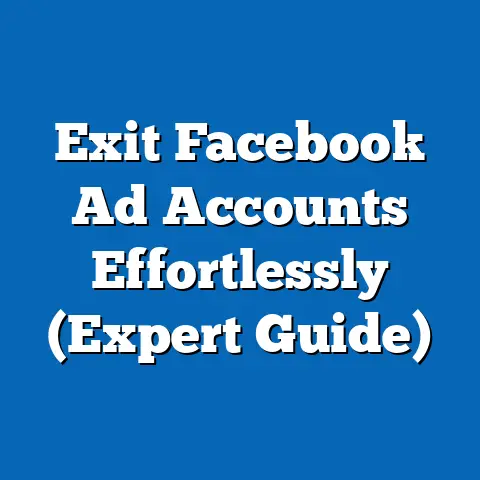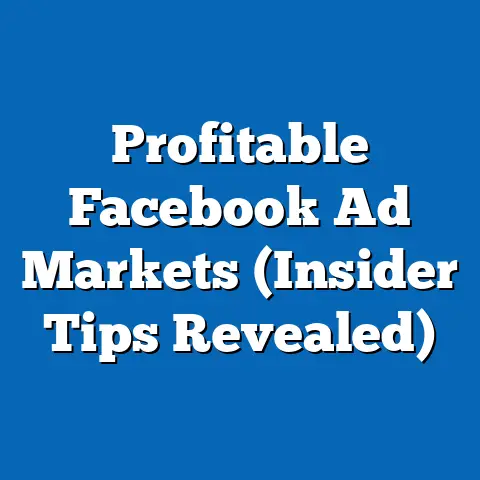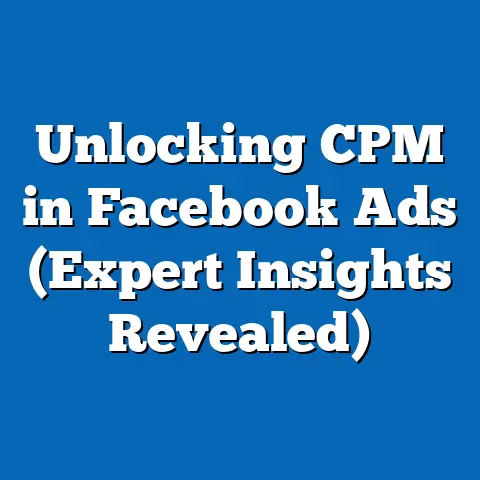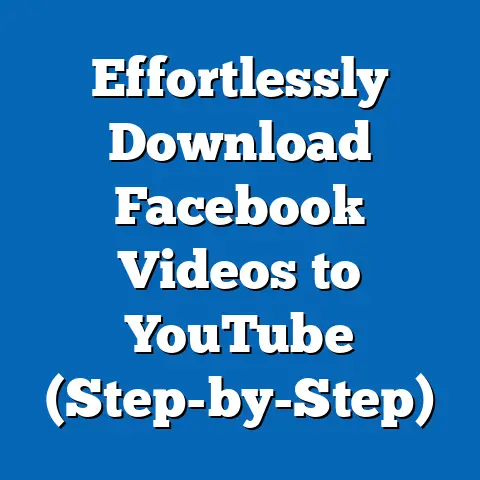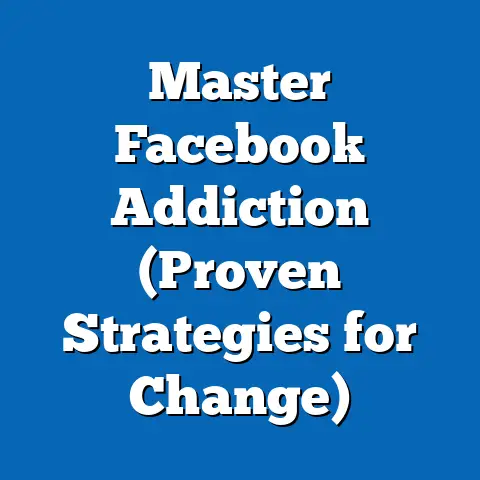Maximize Ad Reach with Facebook (Proven Strategies)
Ever tried yelling your order at a crowded concert? That’s what it feels like trying to get your Facebook ad noticed. Everyone’s clamoring for attention, posting cat videos, sharing political rants, and, yes, trying to sell stuff. It’s a digital cacophony where your carefully crafted ad can easily get lost in the noise. But don’t despair! Maximizing your ad reach on Facebook isn’t about shouting louder; it’s about knowing the right techniques to cut through the noise and connect with your ideal audience. It’s about being the beacon in the digital storm. And trust me, when done right, it can be a game-changer for your business.
Understanding Facebook’s Ad Ecosystem
Facebook’s ad ecosystem is a complex beast, but understanding how it works is the first step to mastering it. Think of it as a giant, ever-changing puzzle.
The Algorithm’s Role
Facebook’s algorithm is the gatekeeper, deciding which ads get shown to whom. It’s not just about who pays the most; relevance is key. The algorithm analyzes countless factors, including:
- Ad Quality: Is your ad visually appealing and engaging?
- Relevance Score: Does your ad resonate with your target audience?
- Bid Amount: How much are you willing to pay to reach your audience?
- Estimated Action Rates: How likely are people to click, like, or share your ad?
I remember a time when I launched a campaign with a decent budget, but the ad quality was subpar. The algorithm penalized me, and my reach was abysmal. Lesson learned: quality trumps quantity.
Audience Targeting and Segmentation
Targeting is the process of identifying and selecting the specific groups of people you want to see your ads. Segmentation takes it a step further, dividing your audience into smaller, more specific groups based on demographics, interests, behaviors, and more.
- Demographics: Age, gender, location, education, etc.
- Interests: Hobbies, passions, and topics they engage with on Facebook.
- Behaviors: Purchase history, online activities, and device usage.
- Custom Audiences: People who have interacted with your business, like website visitors or email subscribers.
The more specific you get, the better your chances of reaching the right people. I once ran a campaign targeting “cat lovers in New York City who own small businesses.” It was incredibly niche, but the engagement rate was through the roof!
Organic vs. Paid Reach
Organic reach refers to the number of unique people who see your content without paid distribution. Paid reach, on the other hand, is the number of people who see your content because you’ve paid to promote it.
Organic reach is becoming increasingly difficult to achieve on Facebook, thanks to the algorithm’s constant adjustments. While creating engaging content is still important, paid advertising is essential for reaching a wider audience and driving meaningful results.
Takeaway: Understanding how Facebook’s algorithm works, mastering audience targeting, and recognizing the difference between organic and paid reach are crucial for maximizing your ad’s potential. It’s the foundation upon which all other strategies are built.
Crafting Compelling Ad Content
Now that you understand the ecosystem, it’s time to create ads that grab attention and drive action. This is where your creativity comes into play.
Attention-Grabbing Headlines and Ad Copy
Your headline is the first thing people see, so it needs to be captivating. Think of it as your elevator pitch. Ad copy should be concise, clear, and compelling, highlighting the benefits of your product or service.
- Use strong verbs: “Discover,” “Transform,” “Unlock.”
- Ask questions: “Are you tired of…?” “Want to learn…?”
- Create urgency: “Limited time offer,” “Sale ends soon.”
- Highlight benefits, not features: “Solve your problem” instead of “Our product has X feature.”
I once saw an ad with the headline “Finally, a solution for…”. It was so vague and intriguing that I had to click. The copy was equally compelling, and I ended up buying the product!
The Power of Visuals
Visuals are the heart and soul of your ad. High-quality images and videos can stop people in their tracks and draw them into your message.
- Use professional-quality images: Avoid blurry or pixelated images.
- Create eye-catching videos: Short, engaging videos are highly effective.
- Use bright colors and bold designs: Make your ad stand out from the crowd.
- Showcase your product in action: Let people see how it works.
I’ve experimented with using user-generated content (UGC) in my ads. The authentic, relatable nature of UGC often outperforms polished, professional visuals.
Storytelling in Ads
People connect with stories. Instead of just listing features, tell a story about how your product or service has helped someone.
- Focus on the customer’s journey: How did they discover your product? What problem did it solve?
- Use emotional language: Connect with people’s feelings.
- Create relatable characters: Let people see themselves in your story.
- Keep it concise: Get to the point quickly.
I once created an ad that told the story of a small business owner struggling to stay afloat during the pandemic. The ad resonated with so many people, and it drove a significant increase in sales.
Takeaway: Compelling ad content is a blend of captivating headlines, visually appealing images, and emotionally resonant storytelling. It’s about creating ads that not only grab attention but also leave a lasting impression.
Targeting Your Audience Effectively
Content is king, but targeting is queen. You can have the most beautiful ad in the world, but if it’s shown to the wrong people, it’s useless.
Facebook’s Targeting Options
Facebook offers a wide range of targeting options, allowing you to reach specific groups of people based on their demographics, interests, behaviors, and connections.
- Demographic Targeting: Target people based on age, gender, location, education, job title, and more.
- Interest Targeting: Target people based on their interests, hobbies, and the pages they like on Facebook.
- Behavior Targeting: Target people based on their purchase history, online activities, and device usage.
- Connection Targeting: Target people who are connected to your Facebook page, app, or event.
I once ran a campaign targeting people who were interested in “hiking” and “outdoor adventures.” I used demographic targeting to narrow it down to people in specific geographic locations. The results were fantastic.
A/B Testing Audience Segments
A/B testing involves creating multiple versions of your ad and showing them to different audience segments to see which performs best.
- Create multiple ad sets: Each ad set should target a different audience segment.
- Test different variables: Headlines, images, ad copy, and targeting options.
- Track your results: Use Facebook Ads Manager to monitor performance.
- Optimize your campaign: Focus on the ad sets that are performing best.
I always A/B test my audience segments. It’s the best way to find out what resonates with your target audience.
Lookalike Audiences
Lookalike audiences are a powerful way to expand your reach while maintaining relevance. Facebook creates lookalike audiences by identifying people who share similar characteristics with your existing customers or website visitors.
- Create a seed audience: This could be your customer list, website visitors, or Facebook page fans.
- Choose a lookalike audience size: A smaller audience will be more similar to your seed audience, while a larger audience will have broader reach.
- Target your lookalike audience with relevant ads: Just like with any other audience, make sure your ads are tailored to their interests.
I’ve used lookalike audiences to reach new customers who are similar to my best customers. It’s a highly effective way to expand your reach and drive sales.
Takeaway: Effective targeting is about understanding your audience, leveraging Facebook’s targeting options, and continuously testing and optimizing your campaigns. It’s the key to reaching the right people with the right message.
Leveraging Facebook Ad Tools and Features
Facebook offers a suite of tools and features designed to help advertisers create, manage, and optimize their campaigns. Mastering these tools is essential for maximizing your ad reach.
Facebook Ads Manager
Ads Manager is your central hub for creating and managing your Facebook ads. It provides a comprehensive overview of your campaigns, allowing you to track performance, adjust budgets, and make changes to your targeting and creative.
- Create new campaigns: Choose your campaign objective, set your budget, and define your target audience.
- Manage ad sets: Create multiple ad sets to target different audience segments.
- Create ads: Design your ads with compelling headlines, images, and ad copy.
- Track performance: Monitor your key metrics, such as reach, impressions, clicks, and conversions.
I spend a lot of time in Ads Manager, constantly monitoring my campaigns and making adjustments as needed. It’s the best way to stay on top of your performance and optimize your results.
Facebook Pixel
Facebook Pixel is a snippet of code that you place on your website to track conversions and optimize your ad performance. It allows you to see what actions people are taking on your website after clicking on your Facebook ad.
- Track conversions: See which ads are driving the most sales, leads, or other desired actions.
- Optimize your campaigns: Focus on the ads that are generating the best results.
- Create custom audiences: Retarget people who have visited your website or taken specific actions.
I always install Facebook Pixel on my websites. It’s essential for tracking conversions and optimizing your ad campaigns.
Retargeting Strategies
Retargeting involves showing ads to people who have previously interacted with your brand, such as website visitors, email subscribers, or Facebook page fans.
- Retarget website visitors: Show ads to people who have visited your website but haven’t yet made a purchase.
- Retarget email subscribers: Show ads to people who are on your email list but haven’t engaged with your content recently.
- Retarget Facebook page fans: Show ads to people who like your Facebook page but haven’t interacted with your posts recently.
Retargeting is a highly effective way to re-engage with people who are already familiar with your brand. I’ve seen significant increases in conversions by using retargeting strategies.
Takeaway: Facebook’s ad tools and features are powerful resources for maximizing your ad reach and driving results. Mastering Ads Manager, implementing Facebook Pixel, and leveraging retargeting strategies are essential for success.
Budgeting and Bidding Strategies
Even the most creative and well-targeted ad campaign can fail if you don’t manage your budget effectively.
Setting an Effective Budget
Setting the right budget is crucial for maximizing your ad reach. You need to strike a balance between spending enough to reach your target audience and not overspending on ineffective ads.
- Daily vs. Lifetime Budgets: Daily budgets allow you to spread your spending evenly throughout the day, while lifetime budgets allow you to set a total amount to spend over a specific period.
- Consider your campaign objective: If your goal is to drive sales, you may need to spend more than if your goal is simply to increase brand awareness.
- Start small and scale up: Begin with a small budget and gradually increase it as you see results.
I usually start with a daily budget and monitor my performance closely. If I see positive results, I’ll gradually increase my budget.
Bidding Strategies
Facebook offers various bidding strategies, allowing you to control how much you pay for each ad impression or click.
- Cost Per Click (CPC): You pay each time someone clicks on your ad.
- Cost Per Thousand Impressions (CPM): You pay for every 1,000 times your ad is shown.
- Cost Per Action (CPA): You pay when someone takes a specific action, such as making a purchase or filling out a form.
I typically use CPC bidding when I’m trying to drive traffic to my website and CPA bidding when I’m trying to generate leads or sales.
Monitoring Ad Performance
Monitoring your ad performance is essential for optimizing your budget and bidding strategies. You need to track your key metrics, such as reach, impressions, clicks, conversions, and cost per result.
- Use Facebook Ads Manager to track your results: Ads Manager provides a comprehensive overview of your campaign performance.
- Analyze your data: Look for trends and patterns that can help you optimize your campaigns.
- Adjust your budget and bidding strategies: Based on your data, make changes to your budget and bidding strategies to improve your results.
I review my ad performance daily and make adjustments as needed. It’s a continuous process of testing, analyzing, and optimizing.
Takeaway: Effective budgeting and bidding strategies are essential for maximizing your ad reach and driving results. Setting the right budget, choosing the right bidding strategy, and monitoring your ad performance are crucial for success.
Conclusion
Maximizing your ad reach on Facebook is not an exact science. It requires a blend of creativity, strategy, and continuous optimization. From understanding the intricacies of the Facebook algorithm to crafting compelling ad content, targeting your audience effectively, leveraging Facebook’s tools, and managing your budget wisely, every step is crucial.
So, the next time you’re trying to get your message heard in the crowded Facebook room, remember these strategies. Instead of yelling louder, you’ll be the one with the spotlight, captivating your audience and driving meaningful results. And who knows, maybe you’ll even start a digital dance party. Now, go out there and make some noise!

